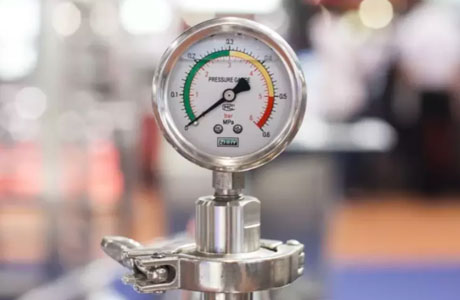What Is A Magnehelic Gauge?
Key Takeaway
A Magnehelic gauge is a device used to measure low differential pressure. It is commonly used in HVAC systems, clean rooms, and industrial applications to monitor air pressure differences.
This gauge works by using a magnetic coupling between a diaphragm and a pointer mechanism. The diaphragm deflects with changes in pressure, and the magnetic linkage moves the needle to display the reading.
Overview and Design of Magnehelic Gauges
Magnehelic gauges are specialized instruments designed for measuring low differential pressures, commonly used in HVAC systems, clean rooms, and laboratories. Their unique design allows for precise and reliable readings, essential for maintaining optimal environmental conditions and system performance. Understanding the overview and design of Magnehelic gauges is crucial for professionals who need to ensure accuracy in pressure measurement.
The gauge operates based on the principle of differential pressure, utilizing a diaphragm and mechanical linkage to provide clear readings. Its robust construction and user-friendly design make it a preferred choice in various applications. By familiarizing themselves with Magnehelic gauges, technicians can effectively monitor and control pressure levels, ensuring the efficiency and safety of their systems.

Applications in HVAC Systems and Cleanrooms
Magnehelic gauges are widely used in HVAC (heating, ventilation, and air conditioning) systems, particularly for measuring differential pressure across filters, ducts, and fans. In HVAC systems, maintaining correct airflow and pressure is crucial for energy efficiency, indoor air quality, and the proper operation of ventilation equipment. The Magnehelic gauge allows operators to monitor pressure differences in these systems to ensure they are functioning correctly.
In cleanrooms, where maintaining specific pressure differentials is essential to prevent contamination, Magnehelic gauges play a vital role. Cleanrooms are designed to have positive or negative pressure to maintain air quality and prevent particles from entering or leaving the room. The Magnehelic gauge helps maintain the integrity of these environments by allowing technicians to monitor pressure changes that could compromise cleanliness.
By providing accurate readings of pressure differentials, Magnehelic gauges help ensure that HVAC systems are working efficiently and cleanrooms remain sterile and controlled. These applications demonstrate the importance of the gauge in maintaining system reliability and environmental control.
Key Features of a Magnehelic Gauge
Magnehelic gauges are valued for their ease of use and reliability. Some of the key features of these gauges include:
High Precision: Magnehelic gauges provide accurate readings of pressure differentials, even in low-pressure environments. This makes them suitable for applications where even small pressure changes are significant.
Clear, Easy-to-Read Display: The analog display allows for quick and easy reading of the pressure differential. The needle points to the exact pressure level, providing immediate feedback without the need for complicated digital readouts.
Durable Construction: The housing is typically made from rugged materials that protect the gauge from environmental factors, ensuring long-lasting performance even in harsh conditions.
Zero Adjustment: The ability to calibrate the gauge to zero ensures accurate readings from the start, allowing users to fine-tune the measurements for precise results.
Low Maintenance: Because there are no electronic components or batteries, Magnehelic gauges are less prone to malfunction and require minimal maintenance.
These features combine to make Magnehelic gauges a reliable and efficient tool for measuring differential pressure in various industrial and commercial applications.
How to Calibrate a Magnehelic Gauge
Calibrating a Magnehelic gauge is crucial to ensure its accuracy. Calibration typically involves setting the gauge to zero pressure and checking the readings against known standards. Here are the basic steps to calibrate a Magnehelic gauge:
1. Ensure Proper Installation: Before calibrating, make sure the Magnehelic gauge is properly installed and securely connected to the system. The pressure ports should be free of blockages and contaminants.
2. Zero the Gauge: Adjust the zero point on the gauge to ensure that it reads zero when there is no pressure differential applied. This is important for maintaining accuracy over time.
3. Apply Known Pressures: Use a calibration standard, such as a reference pressure source or a calibration pump, to apply known pressure differentials to the gauge. Compare the gauge’s reading to the reference value to ensure it is accurate.
4. Make Adjustments: If the gauge reading deviates from the standard, adjust the calibration screw or reset the gauge as needed to match the correct pressure differential.
5. Recheck the Calibration: After adjustments, recheck the readings across the range to ensure accuracy.
Comparison with Other Pressure Gauges
Magnehelic gauges stand out from other pressure gauges due to their unique design and specific applications. Unlike traditional mechanical pressure gauges, which measure absolute pressure or can be prone to mechanical wear and tear, the Magnehelic gauge is designed to measure differential pressure with high precision.
When compared to digital pressure gauges, Magnehelic gauges offer several advantages. They do not require a power source, making them more reliable in environments where electricity may be inconsistent or unavailable. Additionally, the simplicity of an analog display allows for immediate and clear readings without the need for complex digital interfaces.
However, digital pressure gauges often offer more advanced features, such as data logging and remote monitoring, making them a better choice for highly automated systems where real-time data transmission is necessary. While the Magnehelic gauge may not have these high-tech features, it excels in providing accurate, real-time pressure differential readings in environments where simplicity and reliability are paramount.
Conclusion
A Magnehelic gauge is a specialized instrument used for measuring differential pressure, particularly in low-pressure applications. It functions by using a magnetic coupling to translate the pressure difference across a diaphragm into a readable dial. This type of gauge is known for its accuracy and reliability, making it ideal for monitoring air and gas pressures in HVAC systems, clean rooms, and other controlled environments.
Magnehelic gauges are valued for their precise measurement capabilities and ease of use, allowing operators to quickly assess pressure conditions and make necessary adjustments. In doing so, they help maintain optimal performance and safety standards in various industrial and commercial applications.
